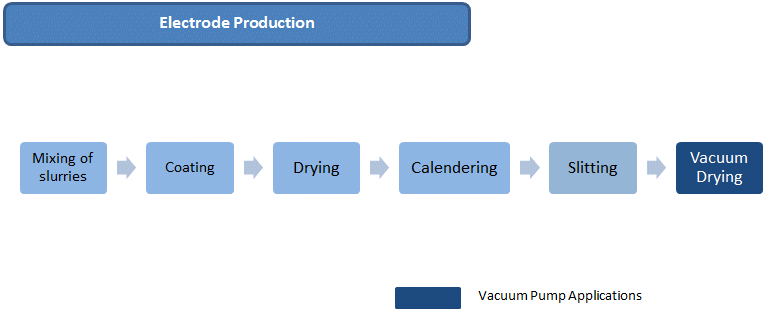Jun 26, 2018
Increasing demand of energy and rising environmental awareness are probing the demand implementation of innovative technologies in energy storage, particularly in the field of renewable energy. This drives more investments on innovative technologies and advanced production process in the field of energy across applications. Implementation of energy storage solutions across various applications faces a lot of challenges in terms of duration of energy storage, number of charges and discharges and so on. Vacuum technology is a common technology implemented across various energy storage applications.
Vacuum Pumps in Lithium-Ion Batteries
One of the major solutions for energy storage is battery. Lithium Ion batteries are one of the best technologies with long term energy storage applications. These batteries come up in different combinations in terms of material used for anodes, cathodes, and separators or in shapes such as flexible pouch cells or rigid prismatic and cylindrical cells. Lithium Ion batteries are extensively used in applications such as mobile phones, tablets, and laptops. Vacuum pumps are used in various stages of battery manufacturing process irrespective of battery type.
Prevention of moisture or water inside the battery is extremely important, as it helps in eliminating unwanted gas inside the battery chamber and while filling the cell with electrolyte. Oil-free multi stage roots vacuum pumps or dry screw pumps are used in various stages of production process to achieve suitable vacuum conditions with high suction capacity.
Application of Vacuum Pumps Lithium-Ion manufacturing Process

Vacuum drying is a process in which the coated electrodes are dried in vacuum for 24 to 48 hours to remove the moisture and solvents. A stable vacuum level of low total pressure of less than 1.10-1 hPa should be maintained throughout the process for evaporation of residual humidity. Multi-stage roots vacuum pumps suit better for these applications, as the pumps should be capable of working on dry basis with high water vapor capacity. The pumps used should have stable high performance and constant drying capacity at low pressures.

Vacuum pumps are used in two stages of battery cell assembly process: Joining and Packing, and Electrolyte Filling. During this process, stacks of electrodes are implanted into the battery cell during the final stage of battery manufacturing and sealed with the help of laser welding or impulse or contact seals based on the type of cell. Due to high sensitivity and repeatability, helium leak detection is considered as the best leak detection method. Similarly, vacuum pumps are used during the process electrolyte filling. For the filling process to happen uniformly and to ensure an even distribution of electrolyte, the process should happen at a stable pace by evacuating the cells from residual humidity and inert gases at a pressure of not more than 1.10-1 hPa to prevent inclusion of gas and seal joints contamination. Dry Screw Pumps are the best suitable for these stages to ensure clean processes and high performance.
Vacuum Pumps in Flywheel storage systems
A recent solution for short term energy storage which is currently used in stationary or mobile systems for wide range applications are the flywheel storage systems. The Flywheel Energy storage system (FESS) operates by storing electric energy as kinetic energy by the motion of the spinning mass (rotor) attached to the stator. When back up is required during power fluctuations or loss, the inertia helps in continuous rotation of the mass which results in conversion of kinetic energy into electricity. The Flywheel is maintained in vacuum to reduce air friction and drag. The material of the rotor is very important as it should have high tensile strength and low modulus of elasticity to maintain a narrow tolerance and achieve high energy density. Tempered steel or Fiber-reinforced synthetics is usually used based on the specifications. The rotor speed varies from tens of thousands of revolutions per minute.
The maximum efficiency of the flywheel is achieved by minimizing the losses due to friction. Vacuum pumps are used for evacuating the closure of Flywheel to achieve the final pressure between 1.10-1 and 1.10-3 hPa to minimize the heat generation and energy loss. Compact dimensions, minimum energy usage, and low-pressure requirements are the key features for the use of vacuum pumps in Flywheel systems. The ideal pump suitable for this application is two stage rotary vane pumps due to its low final pressure, high reliability and low operating costs. Turbopumps are added to the system which requires final pressure low than 1.10-1 hPa. Rotary Vane pumps with DC drive is a special innovation especially for the mobile flywheel applications. The pump operates at 24 V DC within a temperature of -20°C and 60°C and reaches a pressure of 3.10-3 hPa. This predominantly used in automotive industry for energy costs and minimizing costs. Vacuum Gauges are used for measuring the vacuum requirements in the case of stationary flywheel systems.
Conclusions:
The demand for green energy is increasing but has significant technical problems in the execution. Wind and solar power are reliable sources of renewable energy but often have issues in meeting the necessary energy requirements. Energy storage solutions are used to bridge the gap between the energy supply and demand. Vacuum pumps are used either in the production process or within the system to increase the efficiency of the energy storage systems. The compact dimensions, minimum costs, and low-pressure requirements make vacuum pumps ideal solution for energy storage applications.



